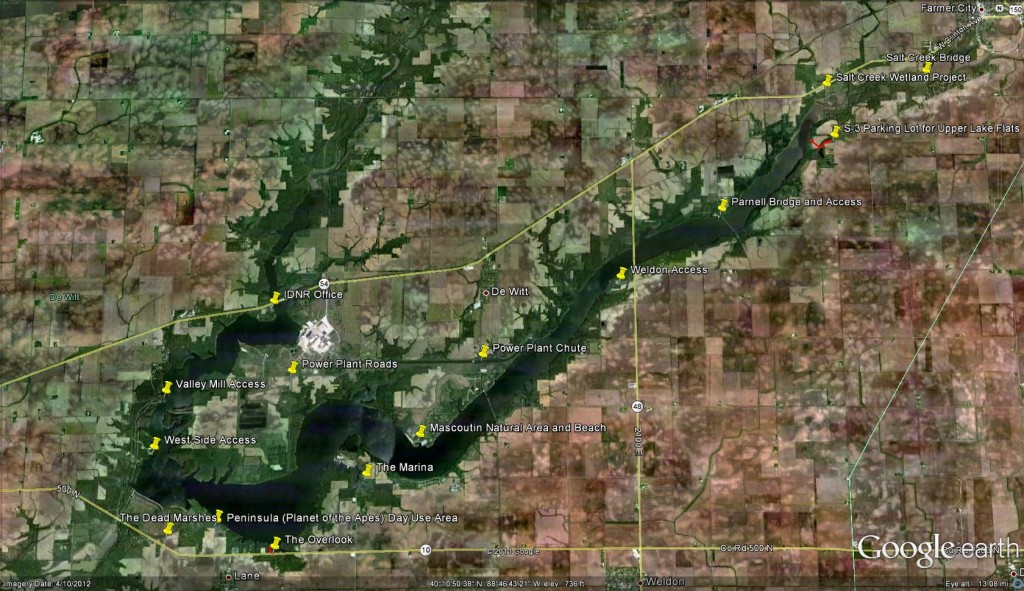Harborside International Golf Course is located at 11001 S. Doty Avenue East in southeast Chicago. Doty Avenue is the frontage road which runs along the east side of I-94 (Bishop Ford Expressway), and it may be easily accessed by exiting I-94 at the 111th, 115th, or 130th Street east exits. The golf course is situated at the northwest corner of Lake Calumet, and clear views of the lake and its various habitats are easily obtained from the clubhouse balcony (a spotting scope is recommended). The facility is normally open from April 1st through October 31st. Species groups found at Harborside since 2002 have typically included waterfowl, wading birds, raptors, shorebirds, and grassland birds.
Harborside International Golf Course is a private facility, but the Harborside management has no objection to birders observing from this location if certain protocols and restrictions are observed. Cameras/photography are forbidden on the premises. Birders are allowed to view from the clubhouse balcony only, but only on days when the balcony is not already in use for a special event. Birders are discouraged from using the balcony from noon to 1 pm, when golf course patrons may be lunching there. To get to the clubhouse balcony, enter the golf course and follow the entrance road to the parking lot. Drive to the east end of the parking lot, park, and walk east to the clubhouse. The balcony is at the east end of the clubhouse.
Birds seen at Harborside Golf Course since 2002 include 27 waterfowl species (21 ducks). Less common waterfowl have included Greater White-fronted Goose, Ross’s Goose, Trumpeter Swan, Tundra Swan, and White-winged Scoter (usually three, but up to six Greater White-fronted Geese were regularly viewed from the clubhouse balcony during May of 2013). Ring-necked Pheasants were commonly heard calling from the clubhouse balcony through 2008, but it appears that this species no longer occurs on the property. Pied-billed & Horned Grebes are commonly seen during the proper season, and an Eared Grebe could be viewed from the clubhouse balcony during May of 2002 and April of 2009. American White Pelicans occur only uncommonly and sporadically during migration.
Nine wader species have occurred since 2002, with less common species including Least Bittern, Snowy Egret, Little Blue Heron, Cattle Egret, and Yellow-crowned Night-Heron. At least twelve raptor species have been seen at Harborside since 2002. Turkey Vultures & Red-tailed Hawks are commonly seen throughout the summer months, but Osprey, American Kestrel, & Peregrine Falcon are also occasionally seen. A pair of Bald Eagles recently built a nest at the tip of the northernmost slip at southeastern Lake Calumet, and the nest (w/incubating adult) could be viewed from the clubhouse balcony during the spring of 2013. Virginia Rail & Sora (and Marsh Wren) may be heard calling from the clubhouse balcony during the proper season, and Common Gallinule has also occasionally been seen from that vantage point.
At least 24 shorebird species have occurred since 2002, with less common species including American Avocet, Willet, Ruddy Turnstone, Red Knot, White-rumped Sandpiper, Baird’s Sandpiper, Stilt Sandpiper, Short-billed & Long-billed Dowitchers, and Wilson’s Phalarope. A few Bonaparte’s Gulls may be seen with the many Ring-billed & Herring Gulls during migration, and a Laughing Gull could be viewed from the clubhouse balcony during June of 2006. A 1st-cycle Great Black-backed Gull lingered throughout May & much of June in 2004. Caspian Terns are regular during summer, and Forster’s, Common, & Black Terns are occasionally seen during migration. A nesting colony of Bank Swallows (50-100+ nest holes) was located at the northeast corner of Lake Calumet (across the lake from the clubhouse balcony) from 2002 – 2009.
A Northern Mockingbird has appeared on the golf course grounds on more than one occasion. Savannah Sparrows, Dickcissels, & Eastern Meadowlarks are commonly heard singing along the Harborside entrance road during June, and Bobolinks have also occurred. As a plus, Franklin’s Ground Squirrels breed on the property and are also occasionally seen along the entrance road.
